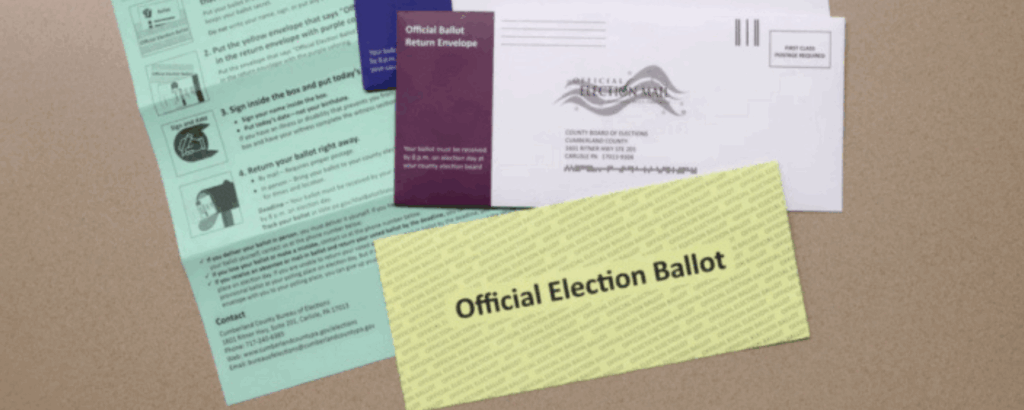The case for keeping Pennsylvania’s mail ballot date requirement
For nearly three years, going back to the November 2022 election, individuals and groups affiliated with the Democratic Party have been waging battles in federal and state courts to nullify a requirement in Pennsylvania law that applies to voting by mail. The rule in question states that the mail ballot must be both signed and dated by the voter; undated or misdated mail-in ballots “shall not be counted.”
The federal case has been taken up by the Third District Court of Appeals, following a March 31, 2025 decision by Judge Susan Baxter of the Western District of Pennsylvania that sided with the plaintiffs and would allow undated or misdated ballots to be counted. The state court challenges have made their way to the state’s Supreme Court, which is now considering the merits.
In essence, the argument against the rule is that it serves no recognized purpose or function beneficial to voting and elections, yet leads to votes being disqualified. Thus, it presents an undue impediment to voters seeking to freely exercise their rights.
Supporters of the rule thus far have had limited success countering this argument. They have contended that the rule helps identify or prevent fraud, but have not been sufficiently clear as to how this is so. They have also maintained that the date requirement preserves the “solemnity” of the act of voting, but this has been dismissed as “nebulous.”
But this debate has addressed the usefulness of the date only in relation to individual voters.
The date requirement can alternatively be assessed from a data science perspective; that is, in relation to how individual, recorded dates might aggregate into a useful data set. Ballot dates in aggregate can provide useful information for monitoring or assessing the timeliness of election officials in the processing and recording of mail ballots, or for identifying and remediating problems, or even malfeasance, along those lines.
Such information may be particularly valuable in situations where process delays more severely affect a particular cohort of voters (distinguished, for example, by race or ethnicity) or one particular district or county. One group having a larger share of ballots rejected for lateness than others should trigger concerns about fair treatment, especially when the comparison is between voters exhibiting the same signature dates.
Not only should the rule be preserved, but ideally the signature dates should be digitized and included as a data item in the mail-in voting database maintained by the state’s Bureau of Elections during the course of an election.
The plaintiffs’ claim of no material purpose to the rule is conceptually unsound for an additional reason, grounded in behavioral science.
Neglecting to follow instructions by writing the date alongside the signature on a signed ballot is undoubtedly attributable to inattention, distraction, or oversight. However, similar cognitive lapses may cause some voters to miss the ballot return deadline, and the date rule may function as a “nudge” to prevent such lapses.
In other words, the number of ballots rejected because of missing or invalid dates is insufficient information to determine how many votes would have been recorded in the absence of the date requirement. That determination requires also knowing how many voters would have missed the return deadline if not for the nudge that accompanies recalling and writing down the calendar date when signing the ballot.
This tradeoff is worth considering, especially as mail ballots are far more frequently disqualified for missing the return deadline than for having missing or invalid dates.
A third weakness of the plaintiffs’ complaint regards the validity of the counts of lost votes that have been bandied about during court proceedings and in public statements. The cogency of the complaint arguably depends on tossed-out votes being frequent enough to be considered more than just idiosyncratic instances of voter negligence, such that the rule places a meaningful burden on voters.
The federal case has been associated with an oft-repeated claim that more than 10,000 ballots were disqualified for missing or incorrect dates in the Nov. 2022 election, which even came to be accepted as fact by Judge Baxter:
“Under current practice, if the date on the outer envelope is incorrect or missing, the ballot is not counted. It is undisputed that in the 2022 general election, over 10,000 mail ballots were disqualified for this reason.”
However, this claim is of murky origin and is straight-out contradicted by a January, 2023 announcement from the PA Department of State stating that the number of ballots rejected in the November election due to date and signature requirements combined was no more than 8,000. The number rejected solely due missing or incorrect dates no doubt was much smaller. Moreover, some voters with disqualified ballots end up voting anyway, either because they are offered a second chance or via provisional voting at the polls.
More recently, opponents of the date requirement have asserted that 4,500 individuals in Pennsylvania were “deprived of their vote” during the 2024 general election due to a missing or invalid date. However, that number seems to be based on an oversimplified calculation. My own, in-depth analysis of data from that election indicates that fewer than half that number, 2,055 individuals, ended up not voting for that reason (equaling one tenth of one percent of returned ballots).
In sum, opposition to the ballot date rule fails to adequately consider its conceptual basis and overstates the counts of votes that have been lost in past elections due to the rule.




